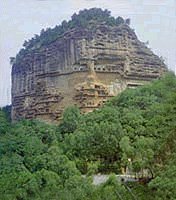Maijishan Grottoes
 Maijishan ("Wheatstack Mountain"), located on the northern side of the Qinling Mountain Range and at a height of 1742m above sea level, gets it's name from its giant, haystack-like shape. The mountain's fame arises not just from its appearance, but from the many Buddhist caves that are gouged into its southwestern face. This is the fourth largest area of concentrated Buddhist grottoes in China, after Dunhuang, Datong and Luoyang. The area around and on the mountain is one of the most beautiful sights in Gansu for both stunning natural, and impressive man-made, scenery. The mountain, studded with caves and strapped by many winding walkways and spiral stairs, rises majestically from the surrounding heavily wooded slopes, so any visitor here with a bit of time on their hands could easily spend a few days hiking and admiring.
Maijishan ("Wheatstack Mountain"), located on the northern side of the Qinling Mountain Range and at a height of 1742m above sea level, gets it's name from its giant, haystack-like shape. The mountain's fame arises not just from its appearance, but from the many Buddhist caves that are gouged into its southwestern face. This is the fourth largest area of concentrated Buddhist grottoes in China, after Dunhuang, Datong and Luoyang. The area around and on the mountain is one of the most beautiful sights in Gansu for both stunning natural, and impressive man-made, scenery. The mountain, studded with caves and strapped by many winding walkways and spiral stairs, rises majestically from the surrounding heavily wooded slopes, so any visitor here with a bit of time on their hands could easily spend a few days hiking and admiring.
It is the Buddhist Grottoes (Maijishan shiku), some dated from as early as the Northern Wei Dynasty (386-534 AD), that most visitors come here to see. On arrival at the sight the most prominent sculpture is the 16m Buddha that is carved high up on the mountain. The grottoes, all packed together on the sheer, rocky cliff faces below and above this, look from afar like chambers of a gargantuan beehive. On ascending the mountain, the grottoes are divided into two sections, the western and eastern, since the central section was almost completely destroyed by an eighth century earthquake. The western section is probably the better, with statues and other Buddhist articles dating mainly from the Northern Wei Dynasty to the Tang (618-907 AD). Just ascending the mountain, on winding, rickety walkways and spiral stairs, with the wooded mountain panorama below, is a breath of fresh air for even the most unconvinced China traveler.
The area itself should be proud of its statistics! After centuries of renovation, expansion, partial destruction and then restoration, the grottoes that you can see today still number an impressive 194. Within these can be found over 7,800 pieces of clay sculptures and stone carvings, and murals with an aggregate area of over one thousand square meters. The stone sculptures that can be seen within the caves are of rock that had to be imported to the mountain, since the local rock was of too soft a consistency. The clay sculptures, reflecting the rich styles of high-ranking daily life, mainly portray two distinct eras: the Northern Dynasties (386-581 AD) characterized by slim figures and the Sui and Tang Dynasties (581-907 AD) featuring plumper ones. The only problem with the grottoes are that they are all locked up and, unless you have brought a guide to open them up, you will have to make do with the limited lighting that the barred entrance affords. For those on a budget this is not such a bad option, since some of them are lit not too badly and the views away from the mountain are worthwhile in themselves. Guides, however, can be bought to open them.
The Grottoes are not the end of a comprehensive trip here. 15m above the giant clay Buddha, on the eastern slope, is the Seven Buddha Pavilion (Qifo ge), a typical Han Dynasty (206 BC-220 AD) construction of interesting architectural value. Recent years have also witnessed the opening of a few of the dilapidated temples around the mountain making the area good for hiking. The best place for such activity is in the Botanical Garden. This is situated in front of the mountain, reached by taking stairs to the right, down the road before the grottoes' ticket office.













No comments:
Post a Comment